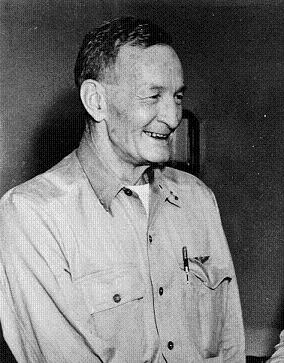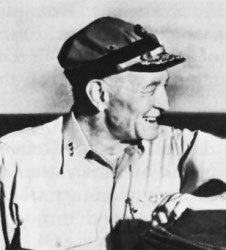![]() The Pacific War Online Encyclopedia
The Pacific War Online Encyclopedia
|
| Previous: Mayasan Maru Class, Japanese Landing Craft Depot Ships | Table of Contents | Next: McCawley Class, U.S. Transports |

National
Archives
#80-G-43065. Cropped by author.
"Slew" McCain was born in Mississippi and attended the University
of Mississippi before transferring to the U.S. Naval Academy, from
which he graduated in 1906. He sailed with the Great White Fleet
on battleship Connecticut and participated
in convoy escort duty during
the First World War. He served on a number of other battleships,
graduated from the Navy War College in 1929, and held several
important positions in the Bureau of Navigation.
Like a number of other senior officers, McCain took flight
training (in 1936) to qualify for an aviation command. (He was a captain
at the time.) He commanded two naval air stations and the Ranger
before being promoted to rear admiral in February 1941. He was
just assuming command of 11
Naval
District when war broke out. He was appointed commander of
all land-based naval air forces in the South Pacific in May 1942,
and was criticized sharply by Turner for
failing to conduct land-based air searches up "The Slot"
following the Guadalcanal
landings and then
failing to notify Turner that the searches had not been carried
out. However, McCain was a favorite of King and escaped censure
for the debacle at Savo
Island. McCain was also one of the first senior officers in
the South
Pacific to recognize that Guadalcanal could become a
"sinkhole" for Japanese air and naval power (Smith 2000).
McCain served as chief of naval aeronautics from October 1942. In
August 1943 he was promoted to vice admiral and named as deputy
Chief of Naval Operations for Air.
McCain returned to the Pacific in the summer of 1944 and was an
observer at the Battle of the Philippine Sea. After
briefly commanding Task Group 38.1, he relieved Pownall as commander
of Task Force 38, and led Halsey's carrier
forces through most of the rest of the war. He died just after the
surrender and was
posthumously promoted to rank of full admiral.
McCain was not popular with more experienced aviators, such as John Towers, Nimitz' air chief, who thought he was a sloppy administrator and a Johnny Come Lately (JCL) to naval aviation. Bogan compared him unfavorably with Mitscher (Tuohy 2007):
Pete Mitscher was a consummate master of naval air power. When he ran it, it was a professional outfit, doing a professional job, in a professional way. When McCain ran it, it was a [expletive] circus. He'd come up with one screwy idea after another. One night we changed the bomb load three times for morning strikes. Those kids had been working 24 hours on the flight deck, and when you have to change a load of bombs on 47 planes three times during the night, because he thought that different bombs might be better on the targets we were going to hit, it was disgusting to me, but there was nothing you could do about it.
On the other hand, McCain took the brunt of the first kamikaze campaign following the Battle of Leyte Gulf, and identified a number of tactics for dealing with the kamikazes that were important later in the war. He led the push for using Hellcats as fighter-bombers, an idea that was not immediately well-received, but won the support of ace fighter leader John Thatch:
This is one of those rare miracles where you get something for nothing. You drop your bomb; then you've got the world's best fighter.

U.S. Army. Via ibiblio.org
McCain rolled his own cigarettes, leaving shreds of tobacco on
his uniform, and often acted on impulse. Like a number of other
prominent military leaders in the Second World War, he wore
distinctive headgear, including a fatigue cap to which his wife
had sewn a black headband and a visor encrusted with gold braid.
McCain's immediate superior, Halsey, sometimes bypassed McCain to
take direct tactical control of the fast carriers. McCain
shared much of the blame with Halsey for twice sailing 3 Fleet into a
typhoon, but McCain
did not have the heroic reputation that allowed Halsey to shrug
off the findings of the Court of Inquiry, and McCain was relieved
by John Towers at about the time of the Japanese decision to surrender.
| 1884-8-19
|
Born at Teoc, Mississippi |
|
| 1906 |
Midshipman
|
Graduates from Naval Academy,
standing 80th in a class of 116 |
| 1915 |
San Diego |
|
| 1926 |
Commander |
Executive officer, BB New Mexico |
| 1928 |
Navy War College |
|
| 1931 |
Commander, AE Nitro |
|
| 1933 |
Head, Planning Division, Bureau of Navigation |
|
| 1936 |
Captain |
Flight training |
| 1937 |
Commander, CV Ranger |
|
| 1940-11-1 |
Commander, San Diego Naval
Air Station |
|
| 1941-2
|
Rear admiral |
Commander, Aircraft, Scouting Forces, Pacific Fleet |
| 1941-12-9
|
Commander, 11
Naval
District |
|
| 1941-12-22
|
Commander, Aircraft, Scouting Forces, Pacific Fleet | |
| 1942-4-10 |
Commander, Patrol Wings, Pacific Fleet | |
| 1942-5-20 |
Commander, Aircraft, South
Pacific |
|
| 1942-10-9
|
Chief, Bureau of Aeronautics |
|
| 1943-8-18 |
Vice admiral |
Deputy Chief of Naval
Operations for Air |
| 1944-1-6 |
Deputy commander, Fast
Carrier
Force |
|
| 1944-8-5 |
Commander, 2
Fast Carrier Task Force |
|
| 1945-9-6 |
Admiral |
Dies |
References
Naval
Historical
Center (accessed 2008-3-3)
Pettibone (2006)
The Pacific War Online Encyclopedia © 2007-2009, 2011, 2013 by Kent G. Budge. Index